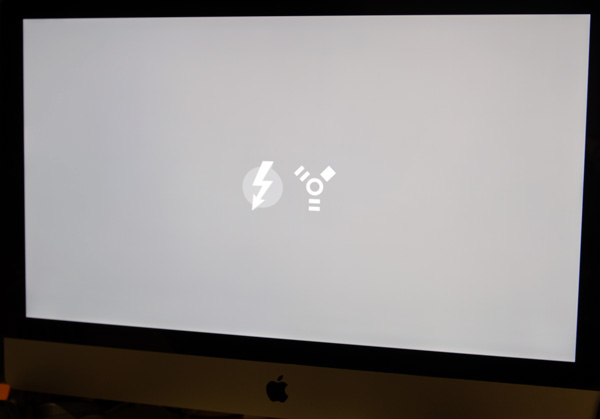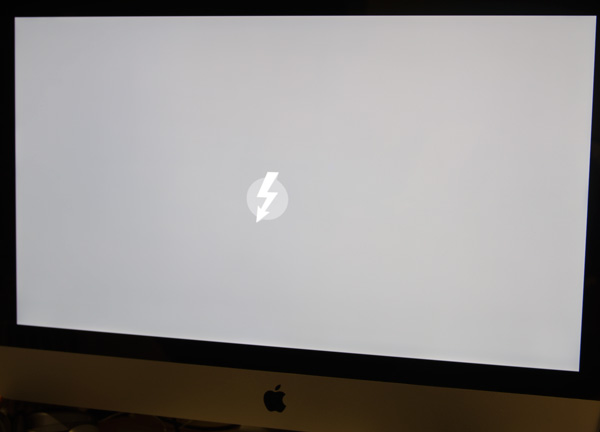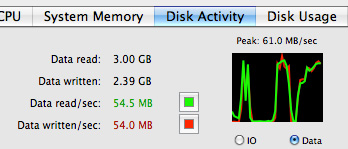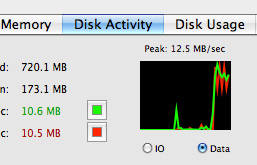Promise Pegasus R6 & Mac Thunderbolt Review
by Anand Lal Shimpi on July 8, 2011 2:01 AM ESTTarget Disk Mode
Another use of Thunderbolt is Target Disk Mode. Connect any two 2011 iMacs, 2011 MacBook Pros or any combination of the two with a Thunderbolt cable, reboot one of them while holding down the T key and you'll boot into target disk mode.

Hold down T and you'll get both Thunderbolt and FireWire logos at boot

With only Thunderbolt connected, the FireWire logo disappears - you're now in Target Disk Mode over TB
In this mode the target Mac boots into a special EFI state that allows all of its drives (HDDs, SSDs, optical, anything connected to the computer) to be mounted by the host Mac. The drives appear like normal removable disks on the host Mac:

MacBook Pro accessing the iMac's sole HDD over Thunderbolt in Target Disk Mode
You even have to eject them all manually before turning off the target Mac.
Don't get too excited though, since the target Mac isn't running full blown OS X it only implements basic storage drivers and optimizations. As a result, peak performance is no where near what Thunderbolt is capable of. Regardless of whether I put the 15-inch MacBook Pro or 27-inch iMac in target disk mode, I never saw more than 61MB/s from the target.

Performance was erratic as well. Sometimes I'd see transfer rates drop all the way down to 9MB/s before jumping up to 30MB/s and then 60MB/s. On average I'd say I saw transfers around 40MB/s.

The functionality is great, however I believe target disk mode would be a killer feature of Thunderbolt if it could operate at peak performance. In its current implementation, it's faster than a WiFi transfer but a bit slower than a good Gigabit Ethernet network transfer. If we could get line speed transfers, being able to move data between two modern Macs at multiple Gbps would be great.










88 Comments
View All Comments
Conner_36 - Friday, July 8, 2011 - link
Or even in the office, to able to take your entire project and move between the rooms carrying ALL of the data? That's unheard of!From what I understand with HD movie editing I/O is the bottleneck.
All we need now is an SVN hardware device with thunderbolt to sync across multiple thunderbolt RAIDs. Once thats out you could have a production studio with some real mobile capabilities.
Exodite - Friday, July 8, 2011 - link
I wager pretty much any usage scenario can come up with a high-performance 12TB storage solution for significantly less than 2000 USD.You're right though, it's definitely not the solution for me.
Or anyone I know, or am likely to ever know. *shrug*
Zandros - Friday, July 8, 2011 - link
What happens if you try the Macbook Pro -> Pegasus -> iMac in Target Display Mode -> Cinema Display connection chain?Focher - Saturday, July 9, 2011 - link
Pretty sure the DP monitor has to be the last device in the chain. Maybe that is just a current limitation because there are no Thunderbolt displays.Zandros - Monday, July 11, 2011 - link
AFAICT, the iMac is a Thunderbolt display, since it does not support Target Display Mode from Display Port sources with Display Port cables.tipoo - Friday, July 8, 2011 - link
Is there a way to make it shut off the drives after idling for a while?piroroadkill - Friday, July 8, 2011 - link
But when you saw the file creation maxed out at 9TB, on 10TB array..Since.. uh, Snow Leopard, Apple changed file and drive sizes to display decimal bytes as used by the manufacturers, which is the same as the 10TB array.
However every other thing ever reports in binary bytes, such as windows describing "gigabytes" even though it means gibibytes in reality.
Ugh, anyway, what I'm trying to get at is that maybe you did infact fill the array. That said, the thing shouldn't have fucked up..
CharonPDX - Friday, July 8, 2011 - link
If I had way too much money, my usage model for Target Display Mode would be to use the iMac as a Virtual Machine host/server, connected to either a second iMac or a MacBook Pro as a dual-screen workstation.With the minimum 27" iMac, you're basically buying a 27" Cinema Display plus a $700 Mac mini-on-steroids. If you want a second Apple display for your iMac or MacBook Pro, and want a Mac Mini to use as a server, that is an excellent value to instead just get a second iMac. (That value may drop depending on the next Mac Mini update, of course.)
etamin - Friday, July 8, 2011 - link
in the block diagram on the first page, why is the Thunderbolt Controller connected to the PCH thru PCIe rather than to the processor? I thought PCIe connections came off the processor/NB?repoman27 - Sunday, July 10, 2011 - link
The lanes that come off the processor/NB are usually used for dGPU. On the new MacBook Pros, Apple borrowed four of them for the Thunderbolt controller. Apparently on the new iMacs, however, they decided to give all 16 lanes from the CPU to the graphics card and pulled four from the PCH instead.